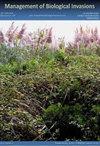抗干燥和愈合再生的太阳珊瑚
IF 1.2
4区 环境科学与生态学
Q3 BIODIVERSITY CONSERVATION
引用次数: 0
摘要
太阳珊瑚,管状珊瑚科。,原产于印度洋-太平洋,但在大西洋的不同地区都有种群。管状孢子虫被认为是巴西的入侵物种,是国家预防、控制和监测计划的目标。这项计划的目标之一是发展科学研究和技术,重点是为防止和管理太阳珊瑚扩散提供补贴。通过控制实验室条件下的操作实验,我们分析了太阳珊瑚群落在不同时间间隔暴露于空气中的影响,为可能使用干燥的管理操作提供一般的生物安全补贴。此外,我们还记录了珊瑚在创伤后因干燥而受损的软组织再生能力。我们观察到管状菌属可以在脱离海水的情况下抵抗长达四个小时而不会受到永久性损伤,尽管它是一种典型的潮下生物。随着暴露在空气中的时间增加,伤口和软组织损失的数量和严重程度增加,这影响了这种珊瑚的恢复能力。只有在暴露于空气中4天后,蜂群才完全死亡(所有珊瑚虫死亡)。此外,在这里首次记录了太阳珊瑚的愈合再生过程。息肉部分保留进食所需软组织的比例决定了整个群体的恢复,这可能在短短两周内发生。这些数据为可能使用干燥的管理操作提供了相关的生物安全补贴。本文章由计算机程序翻译,如有差异,请以英文原文为准。
Resistance to desiccation and healing regeneration in the sun coral
Sun corals, Tubastraea spp . , are native to the Indo-Pacific Ocean, but have established populations in different areas of the Atlantic Ocean. Tubastraea spp. are considered invasive in Brazil, being targets of a National Plan for Prevention, Control and Monitoring. One of the objectives of this plan is to develop scientific research and technology, focused on subsidies for the prevention and management of sun coral dissemination. Through manipulative experiments under controlled laboratory conditions, we analyzed the effects of exposure to air in sun coral colonies during different time intervals, to provide general biosecurity subsidies for possible management operations using desiccation. In addition, we recorded the coral ability to regenerate soft tissues damaged after trauma due to desiccation. We observed that Tubastraea sp. resists up to four hours out of seawater without permanent damage, despite being a typical subtidal organism. The number and severity of wounds and loss of soft tissues increased with exposure time to air, which affected the recovery capacity of this coral. Full mortality of the colonies (all polyps dead) was achieved only after four days of exposure to air. In addition, the healing regeneration process was recorded here for the first time in sun corals. The proportion of polyps partially retaining soft tissues involved in feeding is determining for the recovery of the entire colony, which can occur in just two weeks. Such data offer relevant biosecurity subsidies for possible management operations using desiccation.
求助全文
通过发布文献求助,成功后即可免费获取论文全文。
去求助
来源期刊

Management of Biological Invasions
Agricultural and Biological Sciences-Ecology, Evolution, Behavior and Systematics
CiteScore
3.40
自引率
6.70%
发文量
21
审稿时长
16 weeks
期刊介绍:
Management of Biological Invasions, established in 2010 by Dr. Elias Dana, is an open access, peer-reviewed international journal focusing on applied research in biological invasions in aquatic and terrestrial ecosystems from around the world. This journal is devoted to bridging the gap between scientific research and the use of science in decision-making, regulation and management in the area of invasive species introduction and biodiversity conservation.
Managing biological invasions is a crisis science, with Management of Biological Invasions aiming to provide insights to the issues, to document new forms of detection, measurements and analysis, and to document tangible solutions to this problem.
In addition to original research on applied issues, Management of Biological Invasions publishes technical reports on new management technologies of invasive species and also the proceedings of relevant international meetings. As a platform to encourage informed discussion on matters of national and international importance, we publish viewpoint papers that highlight emerging issues, showcase initiatives, and present opinions of leading researchers.
 求助内容:
求助内容: 应助结果提醒方式:
应助结果提醒方式:


